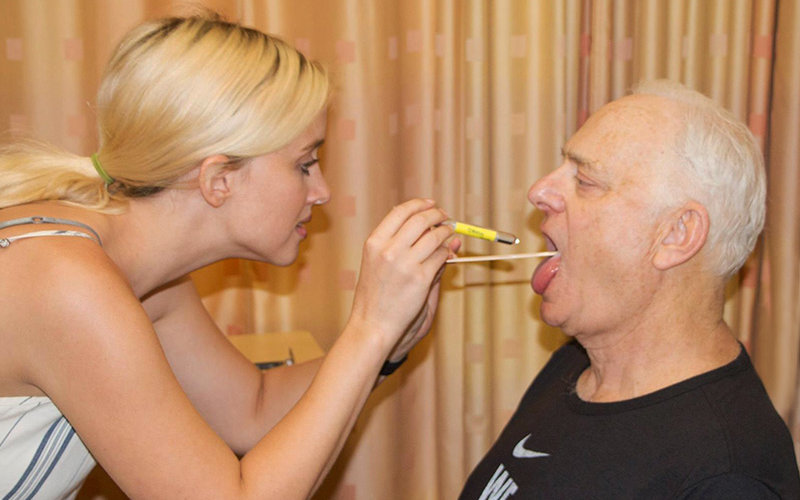
Although highly trained, when nurses enter an examination room, they may face individuals who are scared, in pain or confused.
Beyond finding out what the symptoms may be, nurses must be able to question, explain and respond in a manner that provides comfort for the patient and is easily understood.
Nursing students at Cal State Fullerton are now getting this kind of experience through the standardized patient program.
“Within our Nursing Simulation Lab, our students have opportunities to provide treatment to simulators, but although simulators can help them understand the techniques of medical care, they don’t necessarily help our nursing students learn how to be empathetic, and express their concern and caring,” says Barbara Doyer, lecturer in nursing and coordinator of the Nursing Simulation Lab. “Through this new program, we can provide that extra experience and education.”
Last year, Doyer and fellow lecturer Jane Williams began asking members of the campus Osher Lifelong Learning Institute if they would be interested in volunteering as ‘patients.’ “We came up with guidelines and strict scripts for each interaction,” Doyer explains. “These scenarios involved no testing, just formative assessment.”
The OLLI members were interested and quickly became involved. And it was wildly popular with the nursing students.
“The biggest benefit of having these standardized patients is that it prepares us to interact with actual patients in the hospital,” says Rock Liu, a post baccalaureate student in the accelerated B.S. in nursing program. “In our classes, we learn skills from a nursing perspective and that may involve different ways of thinking and the use of terms that are not obvious to the general public.
“With the standardized patients, we have to communicate in ways patients understand while using very exact words to convey accurate information to them,” Liu adds. “In addition, the questions that standardized patients ask during our mock assessments really help us understand what we are learning, because it takes true understanding to explain a concept to someone without a medical background.
“Practicing with standardized patients made me more comfortable when I went into my clinical rotation, because patient interaction was no longer a daunting new experience for me.”
Earlier this year, Doyer and Williams received a $124,513 Office of Statewide Health Planning and Development grant to fund and grow the effort.
“Thanks to this funding, we’re able to give more students opportunities to take part and to learn,” explains Williams. “We hope to expand, utilizing other campus students as patients.”
“I feel it’s an important component for our students and helps them with their communication skills,” Williams adds. “The volunteers have been extremely supportive and they also are reaping benefits from serving. The experience has helped make them more aware when they go into a doctor’s office or experience a medical situation.”
“It’s a win, win for everyone,” says Jane Goodman, who along with her husband, Marv, were among the first volunteers. “It has taught us so much about our own bodies.”
“Our biggest pleasure is seeing the growth and helping to mold these students,” adds Marv Goodman. “We can see how they are progressing week by week.”
And the value of the experience is spreading. “We’re trying it out in health assessment classes and we’d like to eventually use standardized patients in the testing arena,” says Williams.